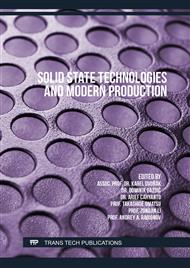[1]
J. Chen, Q. Li, J. Song, D. Song, L. Zhang, X. Shi, Environmentally friendly recycling and effective repairing of cathode powders from spent LiFePO4 batteries, Green Chem. 18(8) (2016) 2500-2506.
DOI: 10.1039/c5gc02650d
Google Scholar
[2]
Information on: https://evreporter.com/lithium-ion-battery-reuse-and-recycling/.
Google Scholar
[3]
M. R. Palacin, A. deGuibert, Why do batteries fail?, Science. 351 (2016) 1253292.
Google Scholar
[4]
X. Zhang, Y. Bian, S. Xu, E. Fan, Q. Xue, Y. Guan, F. Wu, L. Li, R. Chen, Innovative application of acid leaching to regenerate Li(Ni1/3Co1/3Mn1/3)O2 cathodes from spent lithium-ion batteries, ACS Sustain. Chem. Eng. 6 (2018) 5959-5968.
DOI: 10.1021/acssuschemeng.7b04373.s001
Google Scholar
[5]
R. Sattar, S. Ilyas, H. N. Bhatti, A. Ghaffar, Resource recovery of critically-rare metals by hydrometallurgical recycling of spent lithium ion batteries, Purif. Technol. 209 (2019) 725-733.
DOI: 10.1016/j.seppur.2018.09.019
Google Scholar
[6]
X. Chen, Y. Chen, T. Zhou, D. Liu, H. Hu, S. Fan, Hydrometallurgical recovery of metal values from sulfuric acid leaching liquor of spent lithium-ion batteries, Waste Management. 38 (2015) 349-356.
DOI: 10.1016/j.wasman.2014.12.023
Google Scholar
[7]
C. Peng, J. Hamuyuni, B.P. Wilson, M. Lundström, Selective reductive leaching of cobalt and lithium from industrially crushed waste Li-ion batteries in sulfuric acid system, Waste Management. 76 (2018) 582-590.
DOI: 10.1016/j.wasman.2018.02.052
Google Scholar
[8]
Y. Guo, F. Li, H. Zhu, G. Li, J. Huang, W. He, Leaching lithium from the anode electrode materials of spent lithium-ion batteries by hydrochloric acid (HCl), Waste Management. 51 (2016) 227-233.
DOI: 10.1016/j.wasman.2015.11.036
Google Scholar
[9]
K. Shuva, M. A. Hossaini, Dissolution kinetics of cathode of spent lithium ion battery in hydrochloric acid solutions, Journal of The Institution of Engineers (India): Series D: Metallurgical & Materials and Mining Engineering. 94(1) (2013) 13-16.
DOI: 10.1007/s40033-013-0018-0
Google Scholar
[10]
H. Chen, S. Gu, Y. Guo, X. Dai, L. Zeng, K. Wang, C. He, G. Dodbiba, Y. Wei, T. Fujita, Leaching of cathode materials from spent lithium-ion batteries by using a mixture of ascorbic acid and HNO3, Hydrometallurgy. 205 (2021) 105746.
DOI: 10.1016/j.hydromet.2021.105746
Google Scholar
[11]
Y.R. Fajaryanto, N.S. Annisaa, Acid leaching and kinetics study of cobalt recovery from spent lithium-ion batteries with nitric acid, E3S Web of Conferences, EDP Sciences. 67 (2018) 03025.
DOI: 10.1051/e3sconf/20186703025
Google Scholar
[12]
X. Chen, H. Ma, C. Luo, T. Zhou, Recovery of valuable metals from waste cathode materials of spent lithium-ion batteries using mild phosphoric acid, J. of Hazard. Mat. 326 (2017) 77-86.
DOI: 10.1016/j.jhazmat.2016.12.021
Google Scholar
[13]
Y. Fu, Y. He, H. Chen, C. Ye, Q. Lu, R. Li, W. Xie, J. Wang, Effective leaching and extraction of valuable metals from electrode material of spent lithium-ion batteries using mixed organic acids leachant, J. Ind. Eng. Chem. 79 (2019) 154-162.
DOI: 10.1016/j.jiec.2019.06.023
Google Scholar
[14]
P. Meshram, A. Mishra, R. Sahu, Environmental impact of spent lithium ion batteries and green recycling perspectives by organic acids: A review, Chemosphere. (2020) 125291.
DOI: 10.1016/j.chemosphere.2019.125291
Google Scholar
[15]
N. Vieceli, C.A. Nogueira, C. Guimaraes, M.C. Pereira, F.O. Durao, F. Margarido, Hydrometallurgical recycling of lithium-ion batteries by reductive leaching with sodium metabisulphite, Waste Management. 71 (2018) 350-361.
DOI: 10.1016/j.wasman.2017.09.032
Google Scholar
[16]
G.P. Nayaka, Y. Zhang, P. Dong, D. Wang, K.V. Pai, J. Manjanna, G. Santhosh, J. Duan, Z. Zhou, J. Xiao, Effective and environmentally friendly recycling process designed for LiCoO2 cathode powders of spent Li-ion batteries using mixture of mild organic acids, Waste Management. 78 (2018) 51-57.
DOI: 10.1016/j.wasman.2018.05.030
Google Scholar
[17]
F. Meng, Q. Liu, R. Kim, J. Wang, G. Liu, A. Ghahreman, Selective recovery of valuable metals from industrial waste lithium-ion batteries using citric acid under reductive conditions: Leaching optimization and kinetic analysis, Hydrometallurgy. 191 (2020) 105160.
DOI: 10.1016/j.hydromet.2019.105160
Google Scholar
[18]
B. Musariri, G. Akdogan, C. Dorfling, S. Bradshaw, Evaluating organic acids as alternative leaching reagents for metal recovery from lithium ion batteries, Miner. Eng. 137 (2019) 108-117.
DOI: 10.1016/j.mineng.2019.03.027
Google Scholar
[19]
J.R. Almeida, M.N. Moura, R.V. Barrada, E.M.S, Barbieri, M.T.W.D. Carneiro, S.A.D. Ferreira, M.F.F. Lelis, M.B.J.G. Freitas, G.P. Brandão, Composition analysis of the cathode active material of spent Li- ion batteries leached in citric acid solution: a study to monitor and assist recycling processes, Sci. Total Environ. 685 (2019) 589-595.
DOI: 10.1016/j.scitotenv.2019.05.243
Google Scholar
[20]
R. Golmohammadzadeh, F. Faraji, F. Rashchi, Recovery of lithium and cobalt from spent lithium ion batteries (LIBs) using organic acids as leaching reagents: A review, Resour. Conserv. Recycl. 136 (2018) 418-435.
DOI: 10.1016/j.resconrec.2018.04.024
Google Scholar
[21]
R. Golmohammadzadeh, F. Rashchi, E. Vahidi, Recovery of lithium and cobalt from spent lithium-ion batteries using organic acids: Process optimization and kinetic aspects, Waste Management. 64 (2017) 244-254.
DOI: 10.1016/j.wasman.2017.03.037
Google Scholar
[22]
C. Wu, B. Li, C. Yuan, S. Ni, L. Li, Recycling valuable metals from spent lithium-ion batteries by ammonium sulfite-reduction ammonia leaching, Waste Management. 93 (2019) 153-161.
DOI: 10.1016/j.wasman.2019.04.039
Google Scholar
[23]
M. Tanaka, M. Tabata, Stability constants of Metal(II) complexes with amines and aminocarboxylates with special reference to chelation, Bulletin of the Chemical Society of Japan. 82 (2009) 1258-1265.
DOI: 10.1246/bcsj.82.1258
Google Scholar


